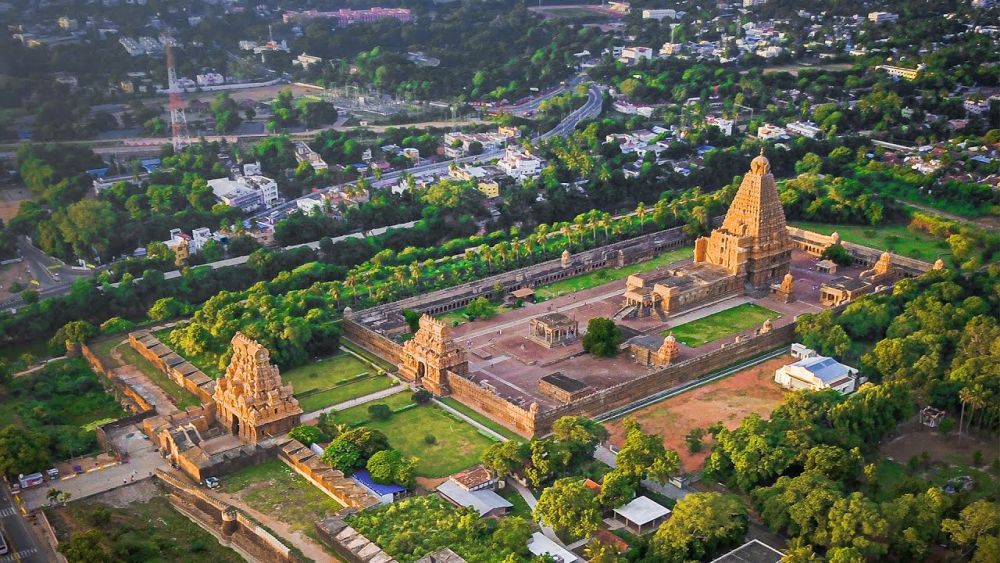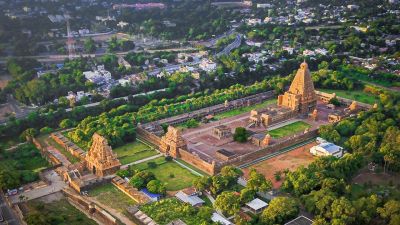

The Brihadeeswarar Temple, also known as the Peruvudaiyar Kovil or the Big Temple, is a renowned architectural marvel in Thanjavur. It is one of the greatest examples of Dravidian architecture and a UNESCO World Heritage Site. This temple, dedicated to Lord Shiva, stands tall as a testament to the grandeur of the Chola dynasty. During your visit, you can marvel at the exquisite stone carvings, massive Nandi statue, and the towering vimana which surpasses 200 feet. The temple complex is also home to a large courtyard and numerous shrines. Photography enthusiasts will find the intricate details on the temple walls captivating. Visitors are often in awe of the temple's scale and the intricacy of its sculptures and frescoes.
The Thanjavur Royal Palace, also known as the Thanjavur Maratha Palace Complex, has a rich history and offers a deep dive into the cultural heritage of Thanjavur. The complex includes the Sadar Mahal Palace, the Queen’s Courtyard, the Durbar Hall, and the Saraswati Mahal Library. Visitors can explore the museum within the palace, which houses an extensive collection of Chola bronzes, stone sculptures, and manuscripts that date back to the medieval period. The art gallery has an array of paintings and sculptures, showcasing the high artistic taste of the Thanjavur rulers. The library within the complex is one of the oldest libraries in Asia, with a vast collection of palm leaf manuscripts in various languages.
The Thanjavur Art Gallery, housed within the Thanjavur Royal Palace, is a treasure trove of South Indian art and crafts. It is especially famous for its collection of bronze and stone statues that date back to the period of the Chola dynasty. The gallery also displays a beautiful array of Thanjavur paintings, unique to this region and known for their vibrant colors and embellishments with gold foils. Visitors can educate themselves on the renowned Thanjavur painting technique and appreciate the fine craftsmanship of jewel-like details that the paintings are known for. The gallery offers a quiet atmosphere to appreciate traditional South Indian art forms and learn about their historical significance.
The Saraswathi Mahal Library, part of the Thanjavur Royal Palace complex, is one of the oldest libraries in Asia with a rich collection of manuscripts and texts. It offers a glimpse into ancient knowledge and wisdom, with works on a variety of subjects such as medicine, history, and astrology. Established during the reign of the Nayak Kings and enriched by the Marathas, the library's vast collection includes over 30,000 Indian and European manuscripts written on palm leaf and paper. Several of these are extremely rare and in various languages like Sanskrit, Tamil, Telugu, and Marathi. It is not just a haven for scholars and researchers but also for casual visitors interested in the history and culture of Thanjavur.
The Schwartz Church is an 18th-century Lutheran church located within the precincts of the Sivaganga Fort in Thanjavur. Built by the Danish missionary, Reverend Frederick Christian Schwartz, in 1779, the church is an example of colonial architecture amidst the predominantly Dravidian temple landscapes of the city. The serene ambiance of the church and its simplistic yet elegant structure present a stark contrast to the elaborate temples. This colonial legacy draws visitors who are interested in exploring the more recent historical layers of Thanjavur's rich heritage.
The Thirukarugavur Temple is an ancient Hindu temple dedicated to Lord Shiva, located in the outskirts of Thanjavur. This temple is known to be particularly significant for couples seeking blessings for progeny. With its intricate Dravidian architecture and calm atmosphere, the temple provides a spiritual retreat from the bustle of the city. Devotees and tourists alike come to soak in the tranquility and spiritual aura of this sacred space. Visiting the temple offers an intimate experience of the devotional practices and cultural traditions of South India.
Raja Rajan Manimandapam is a relatively modern structure built in honor of the great Chola king, Raja Raja Cholan. It is situated near the Brihadeeswarar Temple and includes a well-maintained garden area. The manimandapam is a tribute to the architectural advancements achieved during the king's rule and serves as a center for cultural activities and occasional exhibitions. Visitors can relax in the garden, admire the well-crafted architecture of the mandapam, and immerse in the peaceful atmosphere.
Located around 7 kilometers from Thanjavur, the Punnainallur Mariamman temple is dedicated to the deity Mariamman. It is known for its powerful deity and is frequented by devotees from various parts of Tamil Nadu. The temple's architecture is simple yet vibrant, with colorful statues and a peaceful atmosphere. The temple tank is considered sacred, and the 'Theertham' (holy water) is believed to have healing properties. A visit to this temple is a spiritual journey and offers a chance to observe local religious practices closely.
Although not located within Thanjavur, the Gangaikonda Cholapuram Temple is a must-visit destination for anyone interested in the region's temple architecture. This majestic edifice, around 70 kilometers northeast of Thanjavur, was built by the Chola king Rajendra Chola I. It is a fine example of Tamil architecture during the Chola dynasty and is part of the Great Living Chola Temples UNESCO World Heritage site. Visitors can explore the temple premises and admire the elaborate carvings and sculptures that each tell a story of the ancient past.
Thanjavur is famous for its unique artwork, particularly the Thanjavur dolls and the Thanjavur paintings. These dolls are typically made of terracotta or wood and are known for their bobbing heads and bright colors. The Thanjavur paintings are characterized by rich and vivid colors, simple iconic composition, glittering gold foils overlaid on delicate but extensive gesso work. When in Thanjavur, shopping for these artworks can be a delightful experience. Visitors can head to local markets where artisans sell these traditional crafts, and observe the meticulous effort that goes into creating each piece. Bringing home a Thanjavur doll or a piece of Thanjavur art is like taking back a piece of the city's rich cultural heritage.
